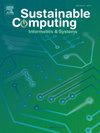物联网资源分配与工作负荷预测的组合优化策略
IF 5.7
3区 计算机科学
Q1 COMPUTER SCIENCE, HARDWARE & ARCHITECTURE
引用次数: 0
摘要
物联网技术的一个重要限制是处理物联网工作负载的多样性和动态性的挑战,这使得准确的工作负载预测和有效的资源分配变得复杂。物联网设备以不同的速度、数量和种类生成大量异构数据,使得传统方法不足以管理这种可变性,并导致资源管理效率低下、性能不佳和运营成本增加。为了解决这些问题,本研究提出了一种新的混合优化算法,即lyrebird - adaptive Kookaburra optimization algorithm - improved Analytic Hierarchy Process (LAKO-IAHP),用于工作量预测和资源分配。该方法包括两个主要阶段:用于工作负载预测的改进层次分析法(IAHP)和用于资源分配的LAKO算法。IAHP阶段通过结合改进的k-means聚类(IKMC)过程和欧几里得距离计算来增强传统的层次分析法(AHP)技术,通过考虑特定的负载平衡(LB)参数(如服务器负载和响应时间)来提高工作负载预测的准确性。在此之后,LAKO算法——一种结合Kookaburra Optimization algorithm (KOA)和Lyrebird Optimization algorithm (LOA)的高级混合方法——执行资源分配阶段,该阶段考虑QoS (Quality of Service)参数,包括不平衡程度、执行时间、可靠性和资源利用率。通过各种性能指标和与现有方法的比较,证明了LAKO-IAHP方法的有效性,证明了其在物联网环境中增强资源管理和保持高性能和可靠性的能力。本文章由计算机程序翻译,如有差异,请以英文原文为准。
Combined optimization strategy for IoT resource allocation with workload prediction
A significant limitation in IoT technology is the challenge of handling the diverse and dynamic nature of IoT workloads, which complicates accurate workload prediction and efficient resource allocation. IoT devices generate vast amounts of heterogeneous data with varying speeds, volumes, and varieties, making traditional methods inadequate for managing this variability and leading to inefficient resource management, suboptimal performance, and increased operational costs. To address these issues, this research proposes a novel hybrid optimization algorithm known as the Lyrebird-Adapted Kookaburra Optimization Algorithm-Improved Analytic Hierarchy Process (LAKO-IAHP) for work load prediction and resource allocation. This approach includes two main phases: the Improved Analytic Hierarchy Process (IAHP) for workload prediction and the LAKO algorithm for resource allocation. The IAHP phase enhances conventional Analytic Hierarchy Process (AHP) techniques by incorporating the Improved k-means clustering (IKMC) process and Euclidean distance calculations to improve the accuracy of workload predictions by considering specific Load Balancing (LB) parameters such as server load and response time. Following this, the LAKO algorithm- an advanced hybrid method combining Kookaburra Optimization Algorithm (KOA) and Lyrebird Optimization Algorithm (LOA)- performs the resource allocation phase, that considers the Quality of Service (QoS) parameters including degree of imbalance, execution time, reliability, and resource utilization. The effectiveness of the LAKO-IAHP approach is demonstrated through various performance metrics and comparisons with existing methods, proving its capability to enhance resource management and maintain high performance and reliability in IoT environments.
求助全文
通过发布文献求助,成功后即可免费获取论文全文。
去求助
来源期刊

Sustainable Computing-Informatics & Systems
COMPUTER SCIENCE, HARDWARE & ARCHITECTUREC-COMPUTER SCIENCE, INFORMATION SYSTEMS
CiteScore
10.70
自引率
4.40%
发文量
142
期刊介绍:
Sustainable computing is a rapidly expanding research area spanning the fields of computer science and engineering, electrical engineering as well as other engineering disciplines. The aim of Sustainable Computing: Informatics and Systems (SUSCOM) is to publish the myriad research findings related to energy-aware and thermal-aware management of computing resource. Equally important is a spectrum of related research issues such as applications of computing that can have ecological and societal impacts. SUSCOM publishes original and timely research papers and survey articles in current areas of power, energy, temperature, and environment related research areas of current importance to readers. SUSCOM has an editorial board comprising prominent researchers from around the world and selects competitively evaluated peer-reviewed papers.
 求助内容:
求助内容: 应助结果提醒方式:
应助结果提醒方式:


